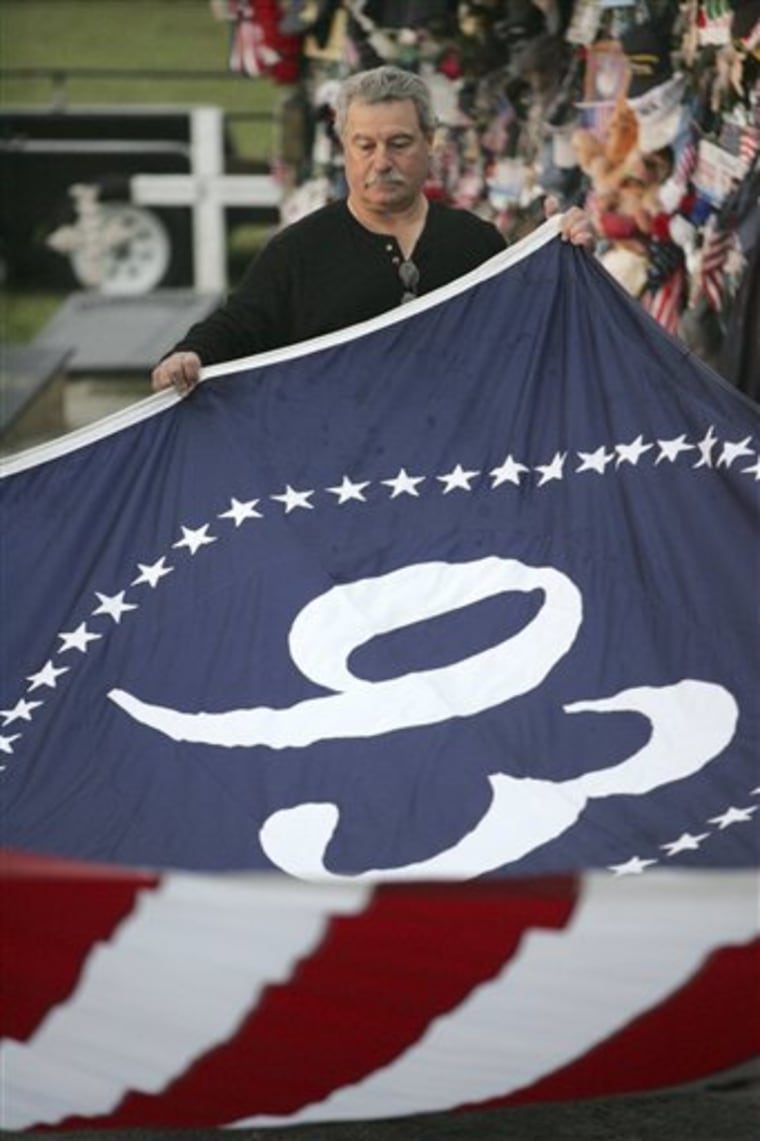One simple notion. Here, some version of it appears on most everything you see — sewn into ballcaps, lovingly painted upon stones, scrawled on sheets of paper. "Never forget." "Remember the fallen." "Always in our hearts." The words vary, but the meaning stays the same.
Before Flight 93 fell from the sky, this patch of southwestern Pennsylvania was a farmer's field, then a strip mine. Then something happened, something unimaginable and unwelcome, national and global. And this place became a place of memory.
Now it is an expanse of informal remembrance — not only of those lost, but of those left behind trying to make sense, nearly a decade later, of the unprocessable.
The memories of Sept. 11, 2001 — the national memories, the institutional ones, the strands of story already sewn into the American tapestry — are, at decade's end, setting into dry cement. A generation has grown into early adulthood since it happened. They know it only from stories and photos and video.
This is what they know:
They know our national narrative now contains words that, a decade ago, were strangers. Ground Zero. The Homeland. Jihad. Al-Qaida. WMD and IED and PTSD. And of course the ones that echo here, in Somerset County's biting wind, the ones that made a legend: "Let's roll."
Endurance
They know the story as it has been told and retold. That we were attacked unjustly, without provocation. That outsiders attacked our cities, our monuments to commerce and defense, and killed fellow citizens who powered the American engine. And that, when they rammed a plane into the Pennsylvania earth, the intruders attacked everyday America, too. They knocked us down, but we got up, rolled up our sleeves and endured.
Together, these memories, a blend of truth and resilience and wishful thinking, offer comfort in the new age of terrorism. They chart not only the recent past but the path ahead. As we clench collectively against another attack, they whisper to us that the American fighter is defined not by the knocking down but by the getting back up.
Memory, of course, is not neutral. Not with 9/11, and not ever, really. It is political, contentious and prone to the power plays of both the deeply involved and the annoyingly distant. Personally and nationally, we remember what we choose, what assuages us and energizes us. "God gave us memory so that we might have roses in December," J.M. Barrie, the man who dreamed up Peter Pan, once wrote.
But here, at the Flight 93 Temporary Memorial, the flavor of memory is different for now because of that word in the middle — "temporary."
Great deeds
Though we do memorials well in America, they tend to keep us at a distance. The Vietnam Wall hushes visitors into contemplation, but it is abstract. The statues scattered around the battlefield at Gettysburg tell us, in their formality, of great deeds burnished by history. Even the expressions of our souvenir culture — the $16.99 plush Lincoln our children can take to bed, the Johnstown Flood snow globe — are affectionate but, somehow, distance us from the events they are sold to evoke.
Not so this plateau outside Shanksville. At the dawn of a new decade, it is the antithesis of a closed book. It is incomplete, unfinished, and by being that way it brings 9/11 to its visitors, right here, right now.
There is a small gray building, populated by an elderly volunteer guide and two security officers. There are benches inscribed with the names of the dead — Todd M. Beamer, Jeremy Logan Glick, Rich Guadagno, Marion Ruth Britton. There are stones, inscribed by sundry people and organizations and placed on the ground.
And there is the wall, a makeshift patchwork of lumber and mesh fencing. It is blank canvas to grief and memory, to flags and patches and hats and notes and rosary beads and commemorative coffee cups. The items are hung with love and care until the fence is full, then removed with love and care to nearby Somerset for archiving — more than 35,000 of them so far.
Raw memories
Somehow this temporary outpouring, this uniquely American installation of emotion-turned-folk art, feels closer to our ordeal than anything permanent ever could. There is no gift shop, no soda-pop machine, no commemorative book to purchase, no plastic toy for kids to covet. There is only raw memory, legend's building blocks.
Last month, victims' families at their side, the requisite officials broke ground for an elegant, 2,200-acre permanent memorial to the 40 souls whose stories ended here. Eventually, they'll close off the rutted, potholed Skyline Road and build a new, gleaming one, and a specially designed shrine for the ages will replace the gray shack and the lumber-and-mesh wall.
More people will come to Shanksville to remember. But the remembering will be different — no longer open wound, but slowly healing scab. Which summons the question that, when it comes to memories of 9/11, so many are reluctant to ask: Is healing what we really want?
___
EDITOR'S NOTE — Ted Anthony covers American culture for The Associated Press.
